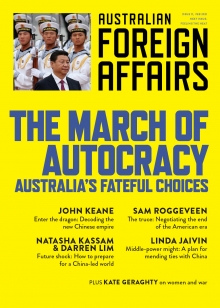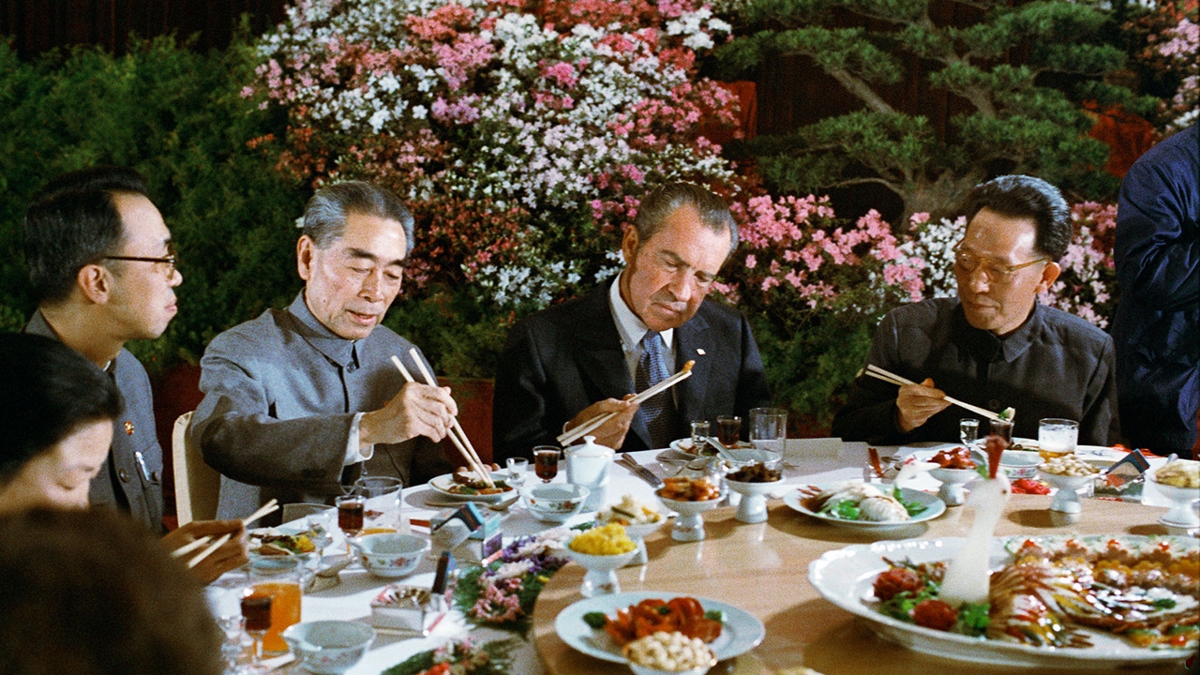
This correspondence is featured in Australian Foreign Affairs 11: The March of Autocracy.
To read the full issue, log in, subscribe or buy the issue.
“Goodbye, America” by Patrick Lawrence
Patrick Lawrence’s essay “Goodbye, America” (AFA10: Friends, Allies and Enemies) argues that America’s focus on Asia is based on an obsolete understanding of regional dynamics and a nostalgic desire to prolong American primacy. Believing otherwise, Lawrence writes, is simply wishful thinking born out of “longing for the once-was, anxiety in the face of change and an appallingly poor grasp of China’s aspirations and intentions”. That assumption underlies the essay’s conclusion that in the face of such US intransigence, Asia should just get on with the business of accommodating Beijing’s interests.
To Lawrence, governments that oppose China are recklessly courting disaster, and mortgaging their national interest to a misguided and disengaged United States. He directs this critique towards several countries. Canberra, Wellington and Tokyo all come in for reproach for displaying variations of America’s “frenzy of Sinophobia”.
Lawrence goes further, arguing that China’s rise has been peaceful, non-imperial, cooperative and supportive of multilateral efforts to resolve disputes. Any nation that does not understand this, in this rendering, misjudges the Chinese government and favours a distant United States whose interests “have never been congruent with anyone else’s.”
One country that does not make his list of reckless actors, however, is China. Curiously, for an essay that is premised on the need to better understand China, there is virtually no discussion of the rapid changes China has undergone, or of the actions it has taken to destabilise, coerce and intimidate virtually every single one of its neighbours.
Yet those changes and actions are key to understanding how nations view and are responding to a more repressive, powerful and aggressive China.
And yet, this essay ignores the domestic changes in China that have made it more challenging to conduct business on equal terms, have made China more repressive and have rendered it even less transparent. Actions that have compromised the sovereignty of multiple countries, sought to harm nations for decisions that do not privilege Beijing’s expanding set of core interests and destabilised the region are either explained away or attributed to Washington’s provocations. Nowhere in this essay is there a discussion of the dramatic changes Xi Jinping has unleashed in China, the confrontational foreign policy Beijing has embarked upon or the sense of alarm China has engendered worldwide.
China’s activities before and during the coronavirus pandemic have resulted not only in sharper policy responses by other governments, but also in a significant hardening of public attitudes towards the Chinese government. For these reasons, an increasing number of nations, by no means just the United States, have undertaken a fundamental reassessment of how and on what terms to deal with Beijing.
Instead of acknowledging any of this, Lawrence echoes Beijing’s talking points by attributing virtually all regional tensions to American provocations. In relation to the South China Sea – where China has occupied and militarised multiple island features, destroyed thousands of acres of coral reef, attacked fishers from multiple countries, ignored the international ruling deeming its claims excessive, interfered with the naval vessels of multiple nations, interrupted lawfully undertaken resource surveys, intimidated coast guards and delayed negotiating a code of conduct for more than a decade – the essay claims that “China seeks nothing more than a role in securing its neighbourhood”.
Freedom-of-navigation operations, legal exercises that demonstrate the United States will not accede to maritime claims that violate international law, are dismissed as a “cynical ruse” that cut against the interests of South-East Asia. Lawrence reports, “I haven’t noted any Malaysian, Filipinos, Vietnamese or Bruneians banging on the Pentagon’s door asking for wandering warships to come their way”. While those countries may have been cautious in their public response to violations of their maritime boundaries and harassment of their citizens and navies, the United States cooperates with each, operates from bases in two of them, and has regularly fielded their requests to deploy more US military assets to the region. As for the nascent quadrilateral grouping of Australia, Japan, India and the United States, Lawrence quotes China’s foreign minister, Wang Yi, who dismissed the Quad as both a deliberate provocation against China and fundamentally unserious, to conclude that “the Pacific littoral will be much better off if events prove Wang right”. No matter that the Quad has taken shape in response to China’s use of military and economic coercion; this essay seems to imply that any steps taken in response to Beijing’s actions are a provocation. Here, as elsewhere, Lawrence reverses cause and effect to portray China as an innocent and aggrieved party.
The insistence on attributing the region’s tensions to Washington’s actions ignores a crucial fact: that much of the United States’ increasingly serious and bipartisan focus on Asia has been a reaction to Beijing’s activities and the demands of America’s allies and partners. What makes this essay so unconvincing, however, is that it fails to take into account that most Asian countries are seeking to balance the threat of an increasingly aggressive China. This is not a US-driven construct, but the reality faced by all of China’s neighbours in the region.
An American presence in the Pacific is not a nostalgic relic, as Lawrence portrays it. The hub-and-spoke model of bilateral security relationships in Asia, as envisioned during the Cold War, was intended to deter aggression against allies and partners, and to moderate security competition among them. This provision of common security had the added benefit of setting the conditions for the Asian economic miracle. Today, a US presence ensures that the region is not subsumed by a Chinese sphere of influence which holds out the promise of economic benefit in exchange for political compliance. Countries, including Australia, have made a determination that such a future is manifestly not in their interests. This has resulted in deliberate policy choices by sovereign governments. It is not, as Lawrence argues, simply outsourcing their defence and their strategic thinking to Washington.
Indeed, the evidence Lawrence offers for the above assessment seems to be that Australia (and others) have chosen to resist China’s encroachments into their internal affairs and its efforts at economic coercion, and strengthened their defence capabilities. In this, Lawrence falls for the most cynical of all Chinese talking points, ascribing the choices of independent nations not to their own agency, but to some kind of deferential and mindless subservience, as US allies. He neglects a more compelling argument – that Canberra and others have indeed been shaping a “new order” that is “expressive of the interests and aspirations of those creating it, and no one else’s”. After all, it just might be possible that multiple countries in Asia believe their aspirations remain theirs to define, and that their futures will be shaped by choices they make.
Charles Edel is a senior fellow at the United States Studies Centre at the University of Sydney and a global fellow at the Wilson Center.







